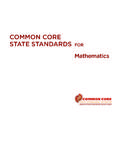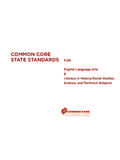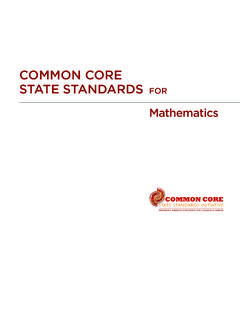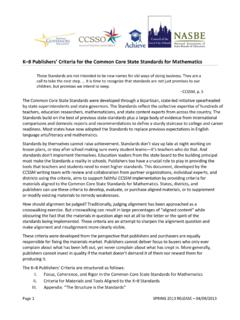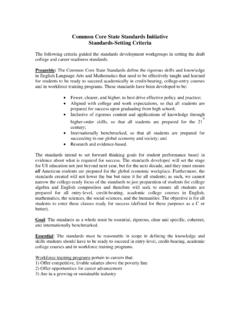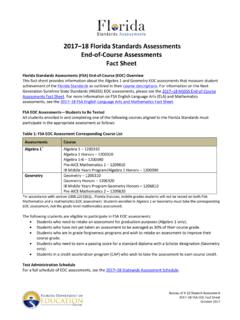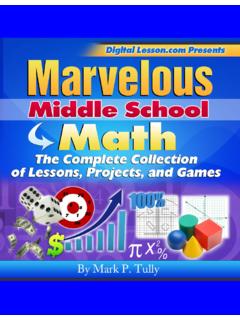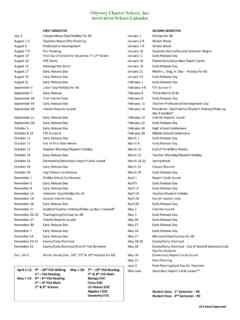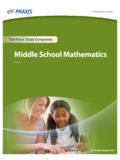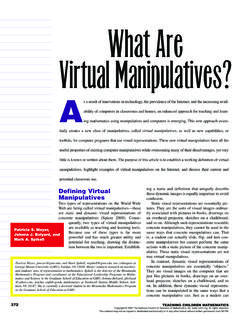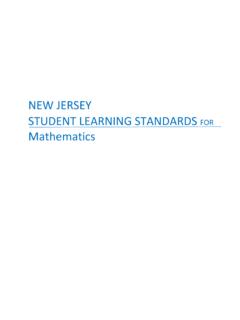Transcription of Mathematics Appendix A Teal1 - corestandards.org
1 Common core state STANDARDS FOR. Mathematics Appendix A: Designing High school Mathematics Courses Based on the Common Core State Standards Common Core State Standards for Mathematics . Overview The Common Core State Standards (CCSS) for Mathematics are organized by grade level in Grades K 8. At the high school level, the standards are organized by conceptual category (number and quantity, algebra, functions, geometry, modeling and probability and statistics), showing the body of knowledge students should learn in each category to be college and career ready, and to be prepared to study more advanced Mathematics .
2 As states consider how to implement the high school standards, an important consideration is how the high school CCSS might be organized into courses that provide a strong foundation for post-secondary success. To address this need, Achieve (in partner- ship with the Common Core writing team) has convened a group of experts, including state Mathematics experts, teachers, Mathematics faculty from two and four year institutions, Mathematics teacher educators, and workforce representatives to develop Model Course Pathways in Mathematics based on the Common Core State Standards.
3 In considering this document, there are four things important to note: 1. The pathways and courses are models, not mandates. They illustrate possible approaches to organizing the content of the CCSS into coherent and rigorous courses that lead to college and career readiness. States and districts are not expected to adopt these courses as is; rather, they are encouraged to use these pathways and courses as a starting point for developing their own. Appendix A: Designing high school Mathematics courses based on the common core state standards |.
4 2. All college and career ready standards (those without a +) are found in each pathway. A few (+) standards are included to increase coherence but are not necessarily expected to be addressed on high stakes assessments. 3. The course descriptions delineate the Mathematics standards to be covered in a course; they are not prescrip- tions for curriculum or pedagogy. Additional work will be needed to create coherent instructional programs that help students achieve these standards. 4. Units within each course are intended to suggest a possible grouping of the standards into coherent blocks; in this way, units may also be considered critical areas or big ideas , and these terms are used interchangeably throughout the document.
5 The ordering of the clusters within a unit follows the order of the standards document in most cases, not the order in which they might be taught. Attention to ordering content within a unit will be needed as instructional programs are developed. 5. While courses are given names for organizational purposes, states and districts are encouraged to carefully con- sider the content in each course and use names that they feel are most appropriate. Similarly, unit titles may be adjusted by states and districts. While the focus of this document is on organizing the Standards for Mathematical Content into model pathways to college and career readiness, the content standards must also be connected to the Standards for Mathematical Practice to ensure that the skills needed for later success are developed.
6 In particular, Modeling (defined by a * in the CCSS) is defined as both a conceptual category for high school Mathematics and a mathematical practice and is an important avenue for motivating students to study Mathematics , for building their understanding of Mathematics , and for preparing them for future success. Development of the pathways into instructional programs will require careful attention to modeling and the mathematical practices. Assessments based on these pathways should reflect both the content and mathematical practices standards.
7 2. Common Core State Standards for Mathematics . The Pathways Four model course pathways are included: 1. An approach typically seen in the (Traditional) that consists of two algebra courses and a geometry course, with some data, probability and statistics included in each course;. 2. An approach typically seen internationally (Integrated) that consists of a sequence of three courses, each of which includes number, algebra, geometry, probability and statistics;. 3. A compacted version of the Traditional pathway where no content is omitted, in which students would complete the content of 7th grade, 8th grade, and the High school Algebra I course in grades 7 (Compacted 7th Grade) and 8.
8 (8th Grade Algebra I), which will enable them to reach Calculus or other college level courses by their senior year. While the K-7 CCSS effectively prepare students for algebra in 8th grade, some standards from 8th grade have been placed in the Accelerated 7th Grade course to make the 8th Grade Algebra I course more manageable;. 4. A compacted version of the Integrated pathway where no content is omitted, in which students would com- plete the content of 7th grade, 8th grade, and the Mathematics I course in grades 7 (Compacted 7th Grade) and 8.
9 (8th Grade Mathematics I), which will enable them to reach Calculus or other college level courses by their senior Appendix A: Designing high school Mathematics courses based on the common core state standards |. year. While the K-7 CCSS effectively prepare students for algebra in 8th grade, some standards from 8th grade have been placed in the Accelerated 7th Grade course to make the 8th Grade Mathematics I course more manageable;. 5. Ultimately, all of these pathways are intended to significantly increase the coherence of high school Mathematics .
10 The non-compacted, or regular, pathways assume Mathematics in each year of high school and lead directly to pre- paredness for college and career readiness. In addition to the three years of study described in the Traditional and Integrated pathways, students should continue to take Mathematics courses throughout their high school career to keep their mathematical understanding and skills fresh for use in training or course work after high school . A variety of courses should be available to students reflecting a range of possible interests; possible options are listed in the following chart.




